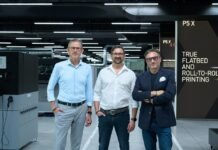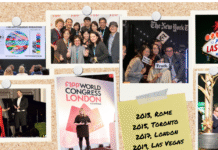During the second quarter of financial year 2021-22 (from 1 July to 30 September 2021), Heidelberg has built on the encouraging developments of the first three months. The market recovery continued in virtually all regions compared with the previous year and, as already announced, the Group’s transformation is working and showing in the operating result. The Group’s half-year sales increased by 22% to €983 million (previous year – €805 million). The EBITDA figure of €75 million was also up on the previous year (€67 million), even though the first half of the previous year was positively influenced by earnings from the restructuring of retirement provision amounting to €73 million, the sale of a subsidiary (€8 million), and the widespread use of short-time working.
During the current reporting period, Heidelberg benefited from rising sales, far better cost-efficiency, and earnings of over €20 million from the sale of docufy, which does not form part of the company’s core business operations. The international logistics bottlenecks throughout the industry were already making themselves felt during the first half of the year in the form of delivery delays. Material supplies were also subject to the familiar pressures. However, close collaboration with suppliers and the approval of alternative components prevented more serious negative effects during this period.
“The highly positive developments in our growth areas and our improved cost-efficiency underline that Heidelberg is doing very well. We also see great potential for the future thanks to our leading position in China and in the areas of digital business models, eMobility, and packaging printing. In addition to all this, our break-even point will continue to fall. Despite the clearly evident problems in the supply chain at present, we are therefore confident about this year and the years to come,” comments Heidelberg CEO Rainer Hundsdörfer.
Continuing progress in the four growth areas
The encouraging developments during the first half-year are based on further improved cost-efficiency and also on continuing progress in the Group’s growth areas, that is to say packaging printing, digital business models, China, and new technology applications, especially in eMobility. Heidelberg is benefiting from continued high growth in its largest single market – China – partly due to the company’s well-established local production operations. The recovery of demand is also based on product innovations such as the new Speedmaster CX 104 universal press, which met with a very positive response at both China Print in June and the Innovation Days in Wiesloch in October of this year. In packaging printing, too, Heidelberg has seen high demand during the half-year, with incoming orders up over 36% on the previous year.
Partnership with Munich Re for subscription model
The financial partnership entered into with Munich Re on 8 November 2021 for digital business models will set the course for future growth. This collaboration is intended to fully harness the global market potential of the subscription options offered by Heidelberg and significantly boost the volume of business in this area. As for new technology offerings, the success of wall-boxes for eMobility continues to stand out, with international expansion gaining further momentum. Following the market launches in Austria and Switzerland, Heidelberg will also be offering its charging solutions in France, Poland, and Hungary in the future. In response to the dynamic growth in demand, the fourth wall-box production line was taken into operation ahead of schedule. Wall-box sales during the half-year have thus tripled and are making a far bigger contribution to the overall result, despite expenditure on product innovation and capacity expansion.

Positive developments in growth areas, the focus on the profitable core business, and consistent implementation of measures to realign the company will be the dominant features at Heidelberg over the next few years, with total cost savings of over €170 million expected in financial year 2022-23.
“At the end of the half-year, we have completely eliminated the net financial debt and improved our free cash flow to €74 million. It’s many years since Heidelberg was last in this situation, but we won’t be complacent and will systematically leverage our future potential to keep the development of these key figures positive,” says the company’s CFO, Marcus A. Wassenberg.
Market recovery reflected in positive operational development
The growing market recovery in virtually all regions continued during the second quarter. At the end of September 2021, incoming orders totaled €1,245 million, which is significantly above the low figure recorded in the previous year due to the pandemic (€864 million). Orders amounting to €593 million in the second quarter were also considerably higher than the previous year’s figure (€518 million). The order backlog increased to €886 million, compared with €627 million at the equivalent stage of the previous year. Group sales for the half-year also grew substantially to €983 million (previous year – €805 million). The figure for the second quarter was €542 million, following on from €475 million in the corresponding period of the previous year.
EBITDA after six months improved to €75 million (first half-year of 2020-21 – €67 million). In the previous year, earnings from restructuring the occupational retirement provision (around €73 million), the extensive use of short-time working to compensate for lower activity levels, and the sale of the Belgian subsidiary CERM (approximately €8 million) had a positive impact. The current reporting period benefited from higher sales volumes, growing savings from the transformation, and earnings of over €20 million from the sale of docufy. EBITDA for the second quarter amounted to €60 million (corresponding quarter of previous year: €27 million), while EBIT after six months totaled €37 million (previous year – €27 million). As already announced, there was a sustained improvement in the financial result from €-27 million to €-17 million, thanks to which the net result before taxes increased from €0 million to €20 million. After taxes, Heidelberg recorded a profit of €13 million, following a figure of €-9 million in the previous year.
Free cash flow improves by €126 million to €74 million
Thanks to the better result, significant improvements in net working capital, and positive effects such as earnings from selling areas of land and docufy, the half-year free cash flow climbed by over €120 million, from €-52 million to €74 million. The positive free cash flow and the further repayment of financial liabilities led to a half-year net financial debt of €-4 million (31 March 2021 – €67 million). Leverage was therefore below zero (corresponding quarter of previous year – 1.2). Due to the positive net result after taxes and the slight increase in the actuarial interest rate for pensions in Germany, the Group’s equity ratio rose from 5.0% on 31 March 2021 to 6.2%. The equity ratio for the Heidelberger Druckmaschinen parent company remains at a solid level of around 27%.
Forecast for year as a whole remains unchanged despite uncertainties
The company is standing by its most recent forecast. Accordingly, Heidelberg is still expecting sales to climb to at least €2 billion. With the sale of docufy, the company predicted an EBITDA margin in the range of 7 to 7.5% on 31 August 2021. Given the increasing rate at which material costs are rising and shortages in the logistics chain, the third quarter will provide a clearer indication of where the EBITDA margin for financial year 2021-22 is likely to lie within this corridor.
Based on a press release from the company and only edited for style. – Editor
















